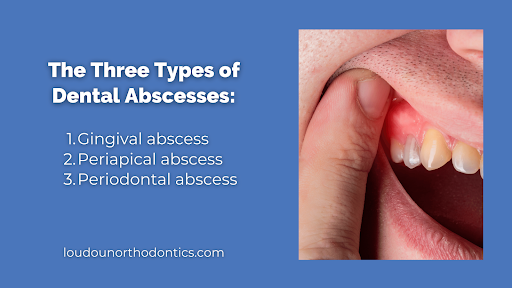Have you been experiencing pain and sensitivity symptoms that don’t go away with pain relief medication? Have you noticed a pocket of pus growing around your painful tooth? You cannot put treatment on hold any longer, as you might be one of the 200,000 Americans dealing with tooth infections every year!
An abscessed tooth is a painful and often severe dental condition that requires prompt attention. It is an infection at the root of a tooth caused by a bacterial infection, leading to pain, swelling, tooth decay, and other complications.
Tooth abscesses are no joking matter. The further the infection has spread, the more it will affect your oral and, consequently, overall health!
Unfortunately, pain meds are not enough to prevent the infection from spreading. So if you notice an amelioration in your symptoms, beware: the tooth pain only disappears because the affected nerve stops functioning altogether. But there’s no stopping the bacteria from attacking and destroying surrounding tissue!
Here at Patuxent Orthodontics, we specialize in making tooth abscesses a thing of the past! Today’s article will discuss the health issues associated with a tooth infection, including its causes, symptoms, treatment options, and ways to prevent it from ever occurring!
What is an Abscessed Tooth?
An abscess is a bacterial infection in the pulp or nerve of a tooth. This infection can occur in any tooth, but it is most commonly found in molars or teeth that have undergone extensive dental work. The condition is usually caused by poor oral hygiene, resulting in the buildup of bacteria and plaque on the teeth and gums.
Age is not a determining factor when discussing dental abscesses — children, adults, and seniors are all vulnerable to this medical condition!
Over time, the infection spreads to the root of the affected tooth and its surrounding tissue, causing swelling and throbbing tooth pain. The pocket of pus forming in different parts of the tooth is your telltale sign that you must rush to the dentist. If left untreated, an abscessed tooth can lead to severe complications, including tooth loss, bone loss, and even sepsis (i.e., the body’s improper response to an infection).

The Three Types of Dental Abscesses
The main dental abscess classification considers the location of the tooth infection in your oral cavity. The three most common tooth infections are:
- Gingival abscess: This infection limits its spread to the gingival tissue and does not usually attack the tooth.
- Periapical abscess: This infection reaches the tooth pulp (i.e., the “living” part of the tooth, filled with nerves and blood vessels). From there, the bacteria spread to the root, causing an abscess to appear.
- Periodontal abscess: This infection, often stemming from gum disease or periodontitis, begins in the tooth’s supporting structure.
How Common is a Tooth Abscess?
Thankfully, dental abscess diagnostics are uncommon in the United States, with only around 200,000 cases reported yearly. But there’s a good chance that tooth infection will never trouble your oral health as long as your teeth are in tip-top condition!
What Causes a Tooth Abscess?
The most common reason behind an abscessed tooth is poor dental health. When food particles and bacteria are not removed from the teeth and gums through regular brushing and flossing, they start to accumulate, forming a sticky film called plaque. Over time, plaque hardens into tartar, which can irritate and inflame the gums, causing them to pull away from the teeth and providing a breeding ground for bacterial infections.
Other factors that contribute to the development of abscessed teeth include:
- Tooth decay: Untreated cavities can penetrate the tooth and reach the pulp, leading to infections.
- Trauma: A blow to the mouth or face can damage the teeth and allow infections to develop.
- Oral health issues: Chronic gum disease weakens the tooth’s supporting structures, making them more vulnerable to infection.
- Weakened immune system: Conditions that weaken the immune system make it harder for the body to fight off infections.
- Unhealthy dietary choices: The more sugar your diet packs, the higher the chance of experiencing dental cavities.
- Dry mouth: Research has shown that experiencing a dry mouth increases the risk of tooth decay.
Tooth Abscess Signs
Depending on how far the infection has spread, you’re likely to experience symptoms such as:
- Severe toothache: The sharp or throbbing pain can radiate to other parts of the face, such as the jaw, ear, or neck.
- Swelling: The gums, cheeks, or neck may be swollen and tender to the touch.
- Sensitivity: The tooth may be sensitive to hot or cold temperatures or pressure.
- Bad breath: A foul odor may emanate from the abscessed tooth.
- Pus: A pus pocket will appear at the infection site, causing an unpleasant taste in the mouth.
- Fever: A fever may develop in severe cases, along with chills and fatigue.
Can an Abscessed Tooth Cause Headaches?
Yes, an abscessed tooth can cause headaches. The pain can radiate to other areas of the head, including the temples, forehead, and behind the eyes. The pressure from the swelling can also cause a headache, especially if the infection is in the upper teeth or sinuses.
Can an Abscessed Tooth Cause Neck Pain?
The inflammation resulting from untreated tooth infections can put pressure on nearby nerves, causing neck pain. The pain can be severe and may radiate to other parts of the body as well, such as the head and the shoulders.
In some cases, an abscessed tooth can also cause swelling in the neck as the infection spreads to the lymph nodes (i.e., a part of the immune system). The swollen lymph nodes will exhibit tenderness as they fight off the infection.
How is an Abscessed Tooth Diagnosed?
It is essential to schedule an appointment with your dental professional immediately if you show signs of a tooth infection. They will thoroughly examine your symptoms to provide a precise diagnosis and a straightforward path toward recovery.
The first step in diagnosing a tooth abscess is discussing your symptoms. Your dentist will ask about the location and intensity of the pain, as well as any other symptoms you might be experiencing. They will also consult your medical history, as some conditions can predispose patients to tooth infections.
Next, your dentist will perform a physical examination of your mouth and teeth. First off, they will test the affected tooth’s sensitivity with a probe and look for signs of inflammation or infection. They may also recommend X-rays of your teeth and jaw to get a better view of the affected area or a computerized tomography (CT) scan to ascertain the extent of the infection.
Your dentist may also perform a pulp vitality test to test the health of the infected tooth’s pulp. This test involves applying heat or cold to the infected area to see how it responds. No response to the stimuli translates into an infected tooth pulp.
Finally, your dentist will recommend visiting an endodontist if they cannot appropriately diagnose the tooth abscess. Endodontists are trained to treat the inside of the tooth, so there’s no one better to determine whether or not you’re dealing with a tooth infection.
How is an Abscessed Tooth Treated?
In the case of a tooth abscess diagnosis, swift treatment is essential if you want to prevent the infection from spreading and causing further complications. Treating a tooth infection typically involves a small incision in the abscess to drain the pus and eliminate the infection. Your dentist will prescribe antibiotics to help manage the discomfort.
A root canal treatment is a practical option if there’s still a chance to save the tooth. The infected inner pulp is replaced with a sterile material to prevent further infections. This procedure will not diminish your tooth’s usefulness, as it can function just as well without the pulp. With enough care, your restored tooth will last you a lifetime!
Worst case scenario, tooth extraction is the only way to prevent the infection from spreading to the surrounding tissue.
How to Prevent Tooth Abscesses
The optimal way to prevent abscessed teeth is to maintain good oral hygiene — the more you care for your teeth, the lower the risk of tooth decay!
These simple steps might sound old and trite, but they’re your strongest assets in preserving your dental health:
- Brush your teeth twice a day, preferably with fluoride toothpaste.
- Floss your teeth regularly.
- Cut down your sugar intake.
- Replace your toothbrush every 3-4 months, as recommended by the American Dental Association (ADA).
- Book appointments with your dentist regularly for routine check-ups.
Dealing With a Tooth Abscess? Patuxent Orthodontics Can Help!
Contact Patuxent Orthodontics if orthodontic care is the way to achieve the beautiful smile of your dreams! Whether you want to learn more about the benefits of our orthodontic services or simply have questions about the process, use our live chat or call (240) 802-7217 or send us a message through our contact us page to connect with our friendly staff today and book a free consultation! Our office, located at 44220 Airport View Dr., Hollywood, MD 20636, proudly serves Maryland’s Patuxent area, as well as the Greater Washington DC area. So, if you’re residing in California, Lexington Park, and Great Mills and are looking for one of the best orthodontists in MD, don’t hesitate to visit our office! We also invite you to keep up with our blog to get answers to many of the frequently asked questions about maintaining sparkling oral health and follow us on Facebook and Instagram to become a part of our smiling community!
References
- Santos-Longhurst, Adrienne. “Abscessed Tooth: Types, Symptoms, Causes, Treatment, and Pictures.” Healthline, Healthline Media, www.healthline.com/health/abscessed-tooth#outlook. Accessed 10 Mar. 2023.
- “Toothbrushes.” American Dental Association, www.ada.org/resources/research/science-and-research-institute/oral-health-topics/toothbrushes. Accessed 10 Mar. 2023.
- “What Is an Endodontist?” Cleveland Clinic, my.clevelandclinic.org/health/articles/16959-endodontics. Accessed 10 Mar. 2023.
- “What Is Sepsis?” Centers for Disease Control and Prevention, Centers for Disease Control and Prevention, www.cdc.gov/sepsis/what-is-sepsis.html. Accessed 10 Mar. 2023.













